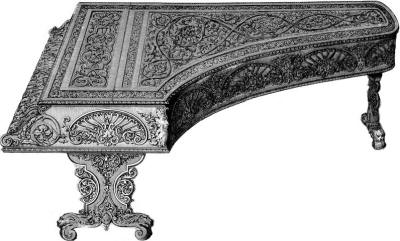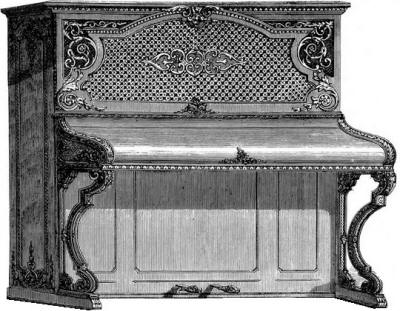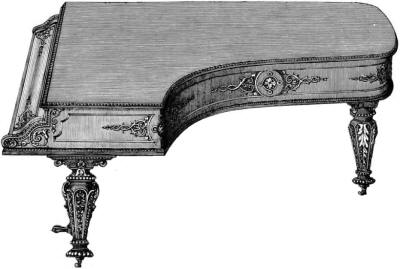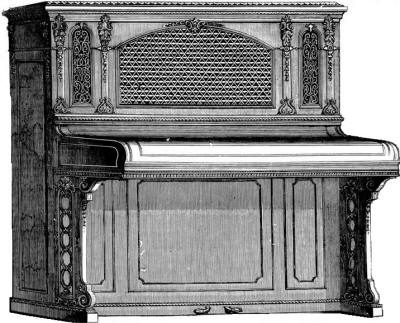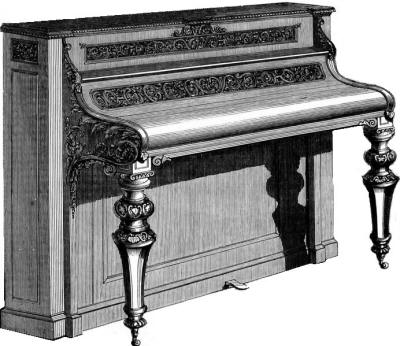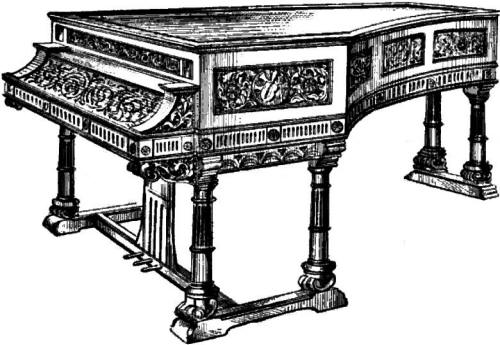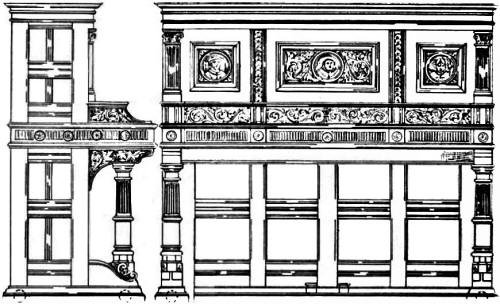home
| Pianoforte-makers
in England
|
KIRKMAN
1851
FT -
IN. FT. - IN. The tone of this lilliputian instrument
is wonderful for its size, and the workmanship throughout is perfect."
Newton's London Journal of Arts and Sciences, 1851,
p. 35
The art and science of pianoforte-making seems to
be concentrated in tl'is little instrument : and were it not there to speak
for itself, no one would believe it possible to produce such clear, full,
and sparkling tones in so small a compass, while no difficulty seems to be
avoided, having 6¾
octaves and all the modern improvements.
[...] Another
improvement, also by Messrs. Kirkman, is tlie addition of metal bracings to
their oblique pianofortes, and the introduction of drilled metal studs and
the harmonic bar fir tiic improvement of the upper notes, so often defective
in this class of instruments."
The Crystal Palace, and its contents : being an
illustrated cyclopaedia of the great exhibition of the industry of all
nations, 1851, p. 42 (archive.org)
1853
1862
Kirkman and Son, of Solio Square; we introduce an illustration in order to show the beauty of the case merely—its exquisite tone is well known to all who had the pleasure of hearing it played upon. The Oblique Grand was exhibited in the Indian Department. It was seven octaves, from A to A, with undcrdampers, repetition action, and all the latest improvements. The rosewood case of this fine instrument was elaborately carved at Madras. The designs and working drawings were sent from England by J. Kirkman and Son; the case was made, and the carvings executed, by the native workmen in the most correct manner. As a specimen of the native Indian skilled labour it is interesting, as showing the ready capability of the native carvers to apply the art in which they excel to any purpose that may be required. The top of this pianoforte is made out of a solid piece of rosewood, without a joint; it is five feet wide, and even in India it is rare to meet with rosewood of such large dimensions." Cassell's Illustrated Exhibitor: Containing about Three Hundred, 1862, p. 272
They also show a new method of mounting the string of the grand on the back bridge. They receive a Medal for beauty of tone and general excellence of construction." Reports by the Juries on the subjects in the thirty-six classes into which ..., 1862, p. 148
Their carved grand in the Indian department we have already noticed. Their other pianos are a concert grand in fine walnut case with carved trusses; a concert grand in English pollard oak, richly carved and gilt; a drawing-room grand in amboyna, a rare and costly wood; and a boudoir grand, inlaid with parquetrie of various woods on a ground of amboyna. This instrument, for beautiful work and high finish, is quite a gem in its way, and is an exquisite specimen of the class of work. The same firm exhibit an oblique pianoforte in walnut and one in amboyna, richly carved and gilt; a cottage pianoforte of very handsome design in ebony and gold; and a cottage pianoforte in walnut, inlaid with tulipwood and ebony, a very pure and chaste design in the Italian style. In one of their grand pianofortes Messrs. Kirkman have a new bridge to prevent the sinking of the sounding-board, which is applied in a very scientific and thoroughly mechanical manner, and for certain classes of pianofortes must be a valuable improvement. Whether for purity, richness, and equality of tone and excellence of touch, fine workmanship, or the elegance of the form of their pianos, the whole display of instruments by Messrs. Kirkman is most creditable to English pianoforte-making." The Illustrated London News, 14/06/1862, p. 616
1865
1867
From English their full grand at 175
guineas, down to the piccolo at 48 pianos. guineas, the instruments are, one
and all, excellent."
Reports on the Paris Universal Exhibition,
1867, Volume 2, p. 199
1872
The cast-iron frames are made in one or two pieces. Uncertainties
surround the operation of casting, as the iron, when cooling, is apt to
shrink unevenly or to curl, all of which incidents are inimical to the
true fitting of the action and strings afterwards.
Messrs. Kirkman,
appreciating the importance of these facts, have adopted steel as the
material for the frames of their best and most expressive pianos.
As may
be well known, steel is much lighter, harder, and more capable of
precise mechanical manipulation than cast or wrought iron.
The
advantages arising from employing this material are therefore apparent.
The tone of this instrument is powerful, round, and even, while the
action is well balanced, and enables the performer to obtain (as
perfectly as any interposed mechanism will allow) nuances of expression
as varied as the violinist produces out of his violin.
And here may be
interposed that a greater perfection of mechanical fitting and of
strength could be obtained if Messrs. Kirkman were to employ some new
kind of steel invented by Sir Joseph Whitworth, who has entirely got rid
of the air-holes which occur in steel castings. The semigrand piano is
made upon a similar mode of construction as the grand. The boudoir grand
is less expensive.
The frame-work is of cast-iron. All the internal
mechanism is thoroughly well executed. Resembling the arrangement
adopted on the Continent, the bass strings, to obtain the greatest
length of string, are strung obliquely above the strings of the alto and
treble clefs of the piano.
This arrangement is not satisfactory, since
it generally affects the tone of the tenor clef, and unless some
compensation is effected in the disposition of the sounding board, by
which a kind of reaction may be created, a twangyness of tone is
noticeable.
Messrs. Kirkman are to be congratulated on having surmounted
this difficulty, since the tone of their boudoir grand piano is
throughout even and pleasant.
The action of each of these three
instruments is a “repetition” one, though, for the matter of that, a
well-constructed action with a medium escapement and good check,
provides, to an average pianist, the means of producing that repetition,
which the soi-disant “repetition” action professes to do for the
beginner or indolent performer."
Journal of the Royal Society of Arts, 1872,
p. 890-891
1885
International Inventions exhibition, South Kensington, London, 1885
The same firm exhibit a cottage case of similar style, also designed by Mr. Edis. The carved panels show medallion heads of celebrated musicians, the spandrels being carved with open scroll work. Both the pianofortes in question are illustrated in Figs. I and 2 on the present and the following page." The Furniture Gazette, 01/07/1885, p. 309
|


